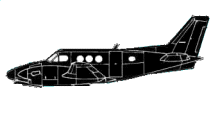
ASN Wikibase Occurrence # 35674
This information is added by users of ASN. Neither ASN nor the Flight Safety Foundation are responsible for the completeness or correctness of this information.
If you feel this information is incomplete or incorrect, you can submit corrected information.
| Date: | Monday 10 June 1996 |
| Time: | 07:00 LT |
| Type: |  Beechcraft E90 King Air |
| Owner/operator: | Ruma Advisory Co Inc |
| Registration: | N916PA |
| MSN: | LW-313 |
| Year of manufacture: | 1979 |
| Total airframe hrs: | 6230 hours |
| Engine model: | P&W PT6A-28 |
| Fatalities: | Fatalities: 2 / Occupants: 2 |
| Aircraft damage: | Destroyed |
| Category: | Accident |
| Location: | Woolwich, ME -
 United States of America United States of America
|
| Phase: | En route |
| Nature: | Executive |
| Departure airport: | Wiscasset, ME (KIWI) |
| Philadelphia, PA (PHL | |
| Investigating agency: | NTSB |
| Confidence Rating: |
The pilot took off on runway 7 and was cleared direct to the Wiscasset NDB, east of the airport. Shortly after takeoff, the airplane began turning to the left. The pilot then asked the controller, '. . . can you tell if I'm in a turn? I have a problem here.' Soon thereafter, the airplane collided with terrain in an uncontrolled descent, about 1.6 miles north of the airport. Investigation revealed that three days before the accident, a refueler had fueled the airplane's left wing with 840 pounds of fuel, then the fuel farm ran out of fuel. No further fueling was accomplished, and the pilot was not advised of the uneven fuel load. Procedures in the Beech E90 Pilot's Operating Manual (POM) included a check of the fuel tanks during preflight. The Beech C90 POM specified a maximum fuel imbalance of 200 pounds, but the E90 POM did not specify a maximum fuel imbalance. During examination of the wreckage, no preimpact malfunction or failure was found.
Probable Cause: failure of the pilot to maintain control of the airplane while climbing after takeoff, due to spatial disorientation, which resulted in an uncontrolled descent and subsequent collision with terrain. Factors relating to the accident were: the improper refueling (servicing of the aircraft) by FBO personnel, and failure of the pilot to note the excessive lateral imbalance of the airplane during preflight.
Accident investigation:
 |
|
Sources:
NTSB NYC96FA123
Revision history:
| Date/time | Contributor | Updates |
|---|---|---|
| 24-Oct-2008 10:30 | ASN archive | Added |
| 02-Feb-2013 12:27 | wf | Updated |
| 02-Feb-2013 12:27 | harro | Updated [Departure airport] |
| 21-Dec-2016 19:22 | ASN Update Bot | Updated [Time, Damage, Category, Investigating agency] |
| 09-Apr-2024 06:27 | ASN Update Bot | Updated [Time, Other fatalities, Departure airport, Destination airport, Source, Narrative, Accident report] |
Corrections or additions? ... Edit this accident description
The Aviation Safety Network is an exclusive service provided by:


 ©2024 Flight Safety Foundation
©2024 Flight Safety Foundation